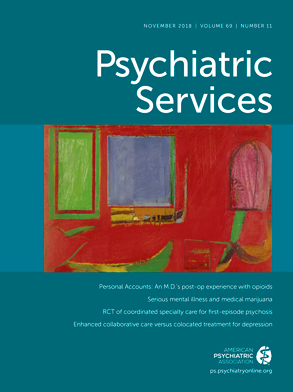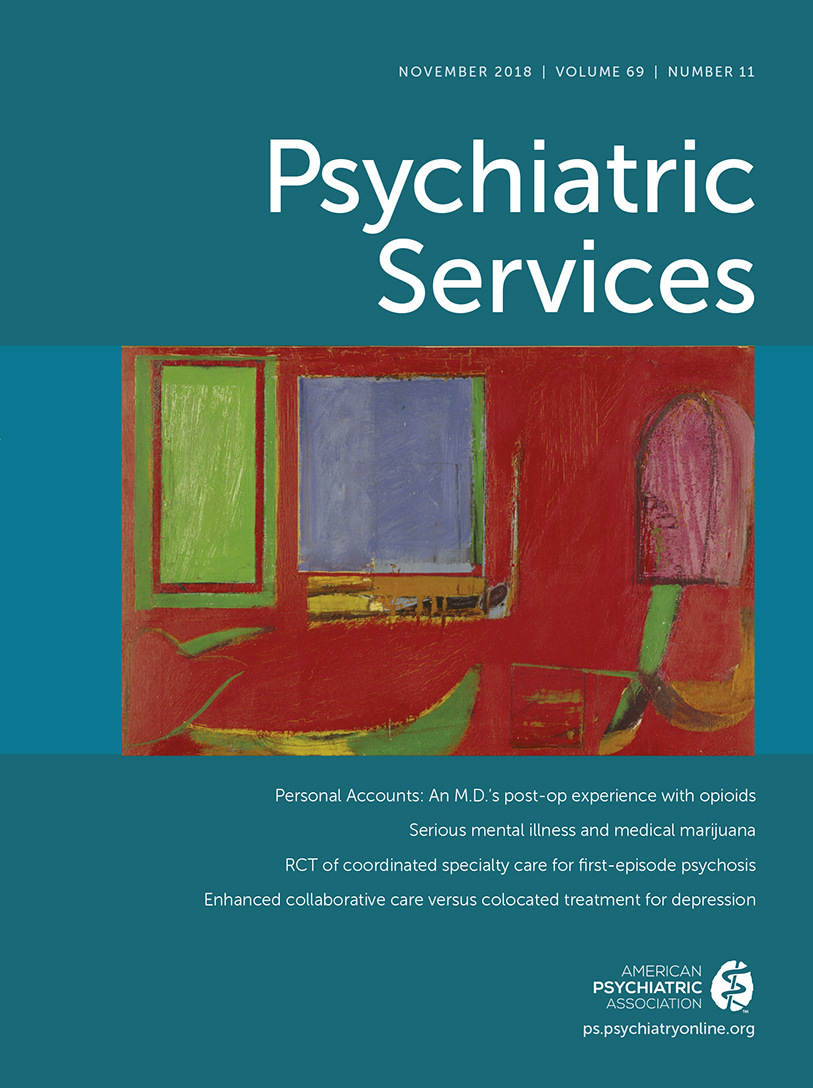Despite the burden of morbidity and mortality associated with the opioid epidemic and mental illness, the health care system response to these public health challenges has been incomplete. Integration of behavioral health care delivery in medical settings can potentially improve health outcomes and save costs, compared with traditional models of care with fragmented systems (
1). One such integrated model is the accountable care organization (ACO), which offers flexible financial structures in return for accepting responsibility for the costs of care for patients assigned to the ACO (
2). Because ACOs are typically held accountable for total health care expenditures, they have the potential to improve value in behavioral health care. Alternatively, concerns have been raised that ACOs could worsen quality for behavioral health care and create incentives to limit care (
3).
The ACO model could motivate hospitals to move payment structures for behavioral health care away from fee-for-service plans, instead incentivizing coordinated care (
1,
2). ACO efforts to incorporate care for substance use disorders and other behavioral health issues have been limited: only 15% of outpatient treatment programs for substance use disorders participate in ACO contracts (
1). Limited studies exploring the impact of ACOs and risk-based payment arrangements on utilization, outcomes, and costs of behavioral health care have shown few effects (
3,
4). Potential reasons for these null findings include inadequate behavioral health performance measures in the payment contracts and behavioral health provider shortages (
3,
4).
Existing work has documented a number of determinants of ACO participation, including prior experience with risk-based payments and care management programs, advanced health information technology, and location in higher-income, urban areas (
5–
7). Organizational characteristics such as nonprofit status, electronic health records implementation, and general medical–surgical hospital type have also been associated with ACO participation (
6). No studies have explored the relationship between the provision of behavioral health services and ACO participation. The cross-sectional study presented here aims to fill that gap.
Data and Procedures
We used data from the 2016 American Hospital Association’s Annual Survey of Hospitals to explore characteristics of hospitals that have participated in ACO contracts and the types of behavioral health services these hospitals offered. There were 6,239 responding hospitals. Of these, we excluded 214 hospitals run by the federal government, because they are unlikely to have participated in an ACO. We also excluded 68 hospitals outside the United States. Because we focused on ACO participation for behavioral health specialty hospitals and general medical–surgical hospitals (referred to as “general hospitals” in this column), we excluded 1,010 hospitals of other types (e.g., surgical, cancer, heart, and rehabilitation). Type of hospital was determined by survey response.
Among the 4,947 hospitals that met the inclusion criteria, 73% (N=3,649) responded to the ACO participation item on the survey, and these hospitals were included in our final study cohort. Characteristics of hospitals that did not answer this item are available upon request.
The outcome of interest was ACO participation. We used responses to an item on the Annual Survey of Hospitals: “Has your hospital or health care system established an accountable care organization?” Hospitals that reported establishment of an ACO were then asked, “If yes, please indicate the patient population that participates in the ACO.” In this column, we use the word “participate” to refer to hospitals or health systems that indicated ACO establishment in the first question. Our final sample included 262 behavioral health specialty hospitals, 1,882 general hospitals with behavioral health services, and 1,505 general hospitals without behavioral health services. Hospitals were categorized as behavioral health specialty hospitals if they selected either alcoholism and other chemical dependency or psychiatric as the category that best described the hospital or the type of service provided to the majority of patients.
To categorize general hospitals based on whether or not they provided behavioral health services, we used items regarding the inpatient and outpatient facilities and services offered. We categorized general hospitals as offering behavioral health services if they provided alcohol-drug abuse or dependency care, psychiatric care, or alcoholism-drug abuse or dependency outpatient services.
We also included five hospital characteristics in our analyses: total staffed beds (<100, 100–399, ≥ 400), teaching status, rural designation, region, and three types of ownership (nonprofit, nongovernment hospitals; for-profit, nongovernment hospitals; and nonfederal government hospitals). We categorized entities as teaching hospitals if they responded positively to at least one of five survey items pertaining to residency training approval, American Medical Association affiliation, Association of American Medical Colleges membership, American Osteopathic Association internship approval, and American Osteopathic Association residency approval. Urbanity was measured using a three-part designation in the survey: rural, micro, and metro. We constructed a binary measure, with rural status as one group, and micro and metro respondents as nonrural.
We used descriptive statistics to compare characteristics of hospitals participating in an ACO with those of hospitals that had not. We used logistic regression to identify factors associated with ACO participation. The Harvard Medical School Institutional Review Board approved all study procedures.
Findings
Thirty-six percent (N=1,313) of hospitals reported that they had participated in an ACO. Rates of ACO participation were 46% (N=856) for general hospitals with behavioral health services, 29% (N=438) for general hospitals without behavioral health services, and 8% (N=21) for behavioral health specialty hospitals (p<.001). [A table showing characteristics of hospitals that participate in ACOs and those that do not is available as an online supplement to this column.]
Of the 856 general hospitals offering behavioral health services that participated in ACOs, 2% (N=17) offered substance use disorder services but no psychiatric services, 65% (N=557) offered psychiatric but no substance use disorder services, and 33% (N=282) offered both substance use disorder and psychiatric services. Similarly, of the 1,026 general hospitals offering behavioral health services that did not participate in an ACO, 3% (N=27) offered substance use disorder but no psychiatric services, 77% (N=792) offered psychiatric but not substance use disorder services, and 20% (N=207) offered both.
After controlling for other hospital characteristics, the analysis showed that behavioral health specialty hospitals were less likely than general hospitals without behavioral health services to have participated in an ACO (odds ratio [OR]=.25, 95% confidence interval [CI]=.16–.41). General hospitals offering behavioral health services were more likely than general hospitals not offering behavioral health services to have participated in an ACO (OR=1.22, CI=1.02–1.45). Consistent with the unadjusted results shown in the first table in the online supplement, larger hospitals, teaching hospitals, and nonrural hospitals were more likely to have participated in an ACO. We also found regional differences. For example, the odds of participating in an ACO were higher for hospitals in New England than in the West South Central region (OR=3.55, CI=2.31–5.45). Nonfederal government hospitals and for-profit, nongovernment hospitals were less likely to participate in an ACO, compared with nonprofit, nongovernment hospitals (OR=.41, CI=.33–.51, and OR=.25, CI=.19–.34, respectively). [A table showing findings from logistic regression analyses is available as an online supplement to this column.]
Among behavioral health specialty hospitals with any ACO relationships, 43% (N=9) had Medicaid ACO patients, 57% (N=12) had private insurance ACO patients, and 81% (N=17) had Medicare ACO patients. The public payer mix was similar for general hospitals, regardless of whether they offered behavioral health services, with about one-quarter reporting Medicaid ACO patients and slightly more than 80% reporting Medicare ACO patients. The share accepting private insurance was higher among general hospitals offering behavioral health services relative to those without behavioral health services (54% [N=456] versus 43% [N=188]).
Implications for Value in Behavioral Health
ACOs represent a mechanism for care systems to improve value (
2). We found behavioral health specialty hospitals were much less likely than general hospitals to have participated in an ACO. This may be because general hospitals are better equipped to provide coordinated health services and take on risk for a defined population (
6). In 2014, 61% of psychiatric inpatient stays occurred in psychiatric specialty hospitals, whereas only 30% occurred in general hospitals with separate psychiatric units (
8). Thus, the potential benefits associated with ACO participation may not be fully transmitted to populations served by behavioral health specialty hospitals. Our finding that general hospitals offering behavioral health services were more likely than general hospitals without behavioral health services to have participated in an ACO may indicate that hospitals offering a broader array of services have greater opportunity to optimize care (
5).
Several characteristics were significantly associated with ACO participation, including size, teaching status, region, ownership, and urban setting. Larger hospitals, which require increased human and capital resources, may have more options than smaller hospitals for increasing the value of care provided in a cost-saving manner (
6). Teaching hospitals may similarly have higher administrative capabilities, facilitating ACO participation. Consistent with previous research, we found greater ACO participation in New England relative to other regions of the country, perhaps because New England has a more robust nonprofit hospital sector (
5). Nonprofit hospitals may participate in ACOs to share financial risk with other providers, whereas for-profit hospitals may delay participating until a demonstrated profit margin is shown (
6). Finally, regarding location, organizations in rural areas may have less capacity than those in urban areas to make the investments necessary to implement ACOs (
9).
Across the three types of hospitals—behavioral health specialty hospitals, general hospitals with behavioral health services, and general hospitals without behavioral health services— Medicare patients are the most common patient population to participate in ACOs. Eighty-four percent of ACO hospitals have Medicare patients in their ACO (presumably from the Medicare Shared Savings Program and the Pioneer ACO Model). Commercially insured patients were also common participants in ACO arrangements undertaken by hospitals of each of the three types. The proportion of Medicaid patients included in ACO arrangements may increase over the next few years, as several states implement ACOs for Medicaid populations. Interestingly, the proportion of behavioral health specialty hospitals in ACOs that include Medicaid patients (43%) was higher than the proportion of general hospitals with ACOs serving these patients (approximately one-quarter). Behavioral health conditions disproportionately affect low-income communities, and Medicaid is a major source of insurance coverage for low-income Americans (
10). Because Medicaid is one of the nation’s largest payers for behavioral health, the higher rates of Medicaid inclusion in behavioral health specialty hospitals with ACO arrangements make sense (
10).
Our findings have important implications about the ability to respond to the opioid crisis. Of the 3,387 general hospitals, 1,505 (44%) offered no behavioral health services; of those that did offer some behavioral health services, just 531 (16%) offered substance use disorder services. In other words, the majority of general hospitals did not provide treatment services for substance use disorders. To comprehensively address the opioid epidemic, improved access to substance use disorder treatment is needed.
This study had several limitations. First, about one-quarter of hospitals did not provide information on ACO participation, and the proportion of behavioral health specialty hospitals that did not provide this information was higher relative to general hospitals (51% of behavioral health specialty hospitals, 38% of general hospitals without behavioral health services, and 6% of general hospitals with behavioral health services). Second, these analyses were observational and cannot be used to draw causal conclusions. Finally, survey responses reflected only the perspective of one administrator at each organization.
Conclusions
Future research should explore reasons for low rates of ACO participation among behavioral health specialty hospitals. Understanding the barriers to ACO participation is an important factor in improving the value of care delivered by hospitals that offer psychiatric and substance use disorder treatment.
Acknowledgments
The authors thank Christina Fu, Ph.D., and Hocine Azeni, M.A., of Harvard Medical School for their expert programming support.

